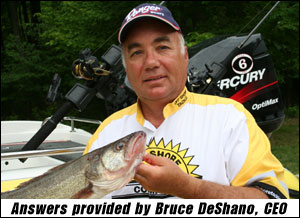Disclaimer:
Our products may change over the years and therefore some
questions may reflect past and/or current product changes.
Instructions sheets are available on this site under the Instruction
Sheets tab.
When new Questions and Answers are loaded onto this site,
the newer ones will be placed directly below each category
heading, which means that products may have changed during
the years and older questions and answers that appear farther
down, may not reflect the current versions of the product.
Question and Answer Categories are:
 
  


DOWNRIGGERS
Q. 050112. I am having trouble with 250 # braided
line being used as downrigger cable. The line slips through
the release when we use your OR2 Medium Tension Stacker
Downrigger Release as we can multi-task with them on other
applications. Accordingly, because the braided line is so
slick, we have to rubber band them to get them to hold.
Those that are not tight enough slip and cause the pads
to become grooved and not hold at all. We are replacing
the pads as time allows but perhaps if this braided line
becomes an accepted replacement for steel cable, some thought
may be needed regarding a tougher pad that is abrasion resistant
to the braided line. It's just a suggestion and I as a charter
boat captain I for one would welcome this innovation.
A. I don't know if that will ever catch on. I think
the consumer will find the cost prohibitive even though
it is a good way to go. You might try our OR18 (Snapper)
for the clip that goes on the wire. Even with that, if you
slip it through the cable (line), even a little, it is going
to grove the pads. If a clip was a solid clamp on the braided
line, it would damage it if you ever ran the clip to the
top of the rigger or had it slide from a snag or something.
As a captain, you're used to maintenance as I was for my
20+ years on the Great Lakes and this is one of those items.
Q. How much bend should there be in the rod when set
on a downrigger?
A. Generally, on hard striking fish such as salmon,
we put a lot of bend in the rod. We do this because the
line is buried deep into the release pads for maximum holding
power and to pick up the slack line faster on the strike.
On light hitting fish such as walleye, we put a very slight
bend in the rod. This is done because the line is set very
light in the release pads. It is also easier to detect a
fish mouthing the bait.
Q. What pound test line do you recommend for downrigger
fishing?
A. Any line type or pound test will work, however
we prefer 17# to 30# premium monofilament line for salmon,
stripers, and other hard hitting fish. For walleye, 10#
to 17# premium monofilament works great.
Q. How deep can the snap weight system go? I fish
a lake where I only need to troll about 20-30 feet down
at most, and I don't want to buy a downrigger for that.
Also, what equipment is necessary with the snap weight system
besides the system itself?
Is there another method for getting down to 20-30 feet besides
a downrigger or a snap weight system?
A. You can easily get down to the 20-30 foot range
with snap weights. Depending on what speed you're going,
you should be able to reach those depths with a 3 ounce
weight and 40 to 60 feet of line after you put the weight
on. I would recommend the weight to be 20 to 50 feet ahead
of the lure.
Nothing additional is needed with the snap weight system
and you can learn more about fishing with them from some
of the articles posted on this website.
Q. I'm just starting to get into open water fishing
in the Great Lakes with downriggers. I was reading on your
web page article about the add-a-line method. I have used
a stacker with another rod but I like this idea of adding
a second line at a controlled depth on the same rod. My
questions are:
1. How far up from the downrigger weight can I go? I have
your downrigger release attached to the back of the cannonball
for the main line but I'm worried about the bow in the line.
This method will bring the main line bow back toward the
wire. Any problem with this? Will this not be a double bow
now?
2. Do I need to provide a stop down near the bottom of
the main line to prevent this extra line from sliding all
of the way down? My concern would be when a fish hits the
main line and this slides down. If the extra line is 6 feet
(give or take) a foot in length, would the stop be at 10
feet preventing this from getting in the way of the fish
or is it best to just let it slide down and trail behind
the fish?
A. This procedure of stacking is easier to do than
talk about but here it goes. First off, you use a black
OR14 or an orange OR19 release attached to about 5 feet
of line (the same pound test as your main fishing line).
I use a snap swivel on each end and one of the split rings
that come with the releases. I set my main line in the cannonball
release, lower the ball 6 to 10 feet and pinch on the OR14
or OR19 release. If I am trying to fish two different water
temperatures, I lower the ball until the stacker would be
at the upper temperature. As for a line stop, none is needed
since the lure on the main line will act as the stop.
|